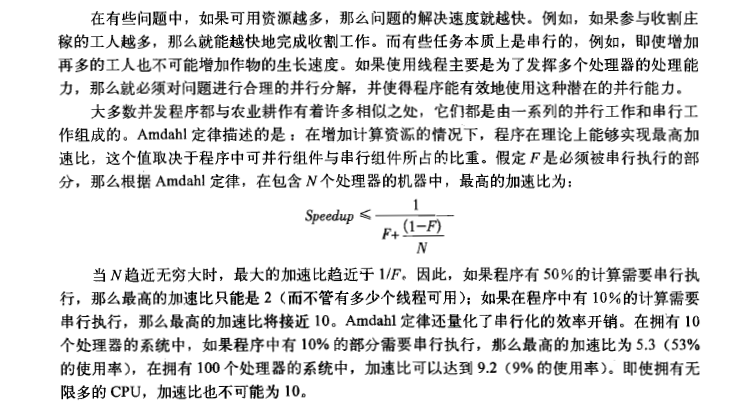性能与可伸缩性
一、Amdahl定律
1.问题和资源的关系
在某些问题中,资源越多解决速度越快;而有些问题则相反:

注意:每个程序中必然有串行的部分,而合理的分析出串行和并行的部分对程序的影响极大;串行部分占比和多核执行效率之间是指数级别的关系
2.ConcurrentLinkedQueue
在多核环境中,这个线程安全的队列比通过synchronizedList生成的队列速度要快很多
可以说:concurrent中提供的类,比通过方法生成的线程安全类速度要快
二、线程开销
由于多线程有开销:所以使用多线程必须保证性能的提升>并发的开销
上下文切换的开销
内存同步的开销
三、减少锁的竞争
1.减少锁持有时间:缩小锁的范围
private final Map<String, String> attributes = new HashMap<String, String>(); //整个方法上锁 public synchronized boolean userLocationMatches(String name, String regexp) { String key = "users." + name + ".location"; String location = attributes.get(key); if (location == null) return false; else return Pattern.matches(regexp, location); } public boolean userLocationMatches(String name, String regexp) { String key = "users." + name + ".location"; String location; //只针对可变状态上锁 synchronized (this) { location = attributes.get(key); } if (location == null) return false; else return Pattern.matches(regexp, location); }
2.降低锁的请求频率:锁分解、锁分段...
锁分解:将一个锁分解为多个锁如:无需在一个原子操作中更新多个状态变量,每个状态变量却用的是同一个类锁,就没必要,每个不相干的状态变量的使用自己的锁就行
public class ServerStatusBeforeSplit { public final Set<String> users; public final Set<String> queries; public ServerStatusBeforeSplit() { users = new HashSet<String>(); queries = new HashSet<String>(); } //每个方法使用 当前class实例锁,类似于synchronized(this),不管是否是操作同一共享状态 public synchronized void addUser(String u) { users.add(u); } public synchronized void addQuery(String q) { queries.add(q); } public synchronized void removeUser(String u) { users.remove(u); } public synchronized void removeQuery(String q) { queries.remove(q); } } public class ServerStatusAfterSplit { public final Set<String> users; public final Set<String> queries; //操作同一 状态的方法 使用相同的锁 public ServerStatusAfterSplit() { users = new HashSet<String>(); queries = new HashSet<String>(); } public void addUser(String u) { synchronized (users) { users.add(u); } } public void addQuery(String q) { synchronized (queries) { queries.add(q); } } public void removeUser(String u) { synchronized (users) { users.remove(u); } } public void removeQuery(String q) { synchronized (users) { queries.remove(q); } } }
锁分段:如将map桶分成不同的段,每个段都有一个锁,这样,在执行某些操作如get,就可以持有不同的锁从而提高并发效率,当然有些操作需要同时持有容器所有段的锁如clear等
//Map分段锁实现 public class StripedMap { // Synchronization policy: buckets[n] guarded by locks[n%N_LOCKS] private static final int N_LOCKS = 16; //锁数量 private final Node[] buckets; //容器桶 private final Object[] locks; //同步监听器对象数组 private static class Node { Node next; Object key; Object value; } public StripedMap(int numBuckets) { buckets = new Node[numBuckets]; locks = new Object[N_LOCKS]; for (int i = 0; i < N_LOCKS; i++) locks[i] = new Object(); } private final int hash(Object key) { return Math.abs(key.hashCode() % buckets.length); } public Object get(Object key) { int hash = hash(key); //获取当前 key对应的index区域的锁,只获取了一个锁 synchronized (locks[hash % N_LOCKS]) { for (Node m = buckets[hash]; m != null; m = m.next) if (m.key.equals(key)) return m.value; } return null; } public void clear() { for (int i = 0; i < buckets.length; i++) { //获取 每个i对应的锁,就是获取了整个容器所有的分段锁 synchronized (locks[i % N_LOCKS]) { buckets[i] = null; } } } }
3.避免热点域
热点资源的锁竞争激烈,导致的性能问题
4.替代独占锁
如:读-写锁:读读可并行,来防止独占;使用原子状态量;使用并发容器;使用不可变对象等
5.减少上下文切换
任务在阻塞于非阻塞的状态中切换,就类似于一次上下文切换
如:日志,日志的打印和IO操作会导致大量的阻塞和释放,导致性能问题